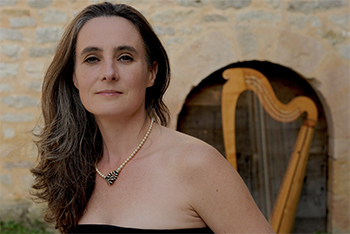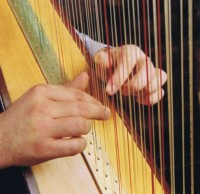by Mike Telin

The concerts, held on Saturday, March 10 at 8:00 pm in Lakewood Congregational Church, and on Sunday, March 11 at 4:00 pm at Plymouth Church in Shaker Heights, will feature soprano Clara Rottsolk, harpist Maria Christina Cleary, oboist Debra Nagy, violinists Julie Andrijeski and Scott Metcalfe, violist Allison Monroe, viola da gambist Jaap ter Linden, and harpsichordist Eric Milnes. Tickets are available online.
On Saturday at 3:00 pm at the Bop Stop, the ensemble will present “Instrument of the Angels,” an LD@Play family concert. Registration is recommended.
In an email Debra Nagy said that she is thrilled to bring Maria Christina Cleary from Milan, Italy for these performances.
“Maria is a pioneer of historical harp playing and a virtuoso on the Baroque triple harp. I first encountered her a couple of years ago in San Francisco, when she was performing Handel’s Harp Concerto. Sitting just a couple of chairs away from her that week, I was utterly transfixed by her playing and I knew that I had to find a way to bring her to Cleveland.”
I caught up with Maria Christina Cleary by telephone and began our conversation by asking her to say a few words about her unique instrument.
Maria Christina Cleary: It’s an Italian Baroque harp, an instrument that was used in the 17th century mostly in Italy, although it was known across Europe. It doesn’t have pedals like the harps you see nowadays in a symphony orchestra, but three rows of strings that are chromatic. One row for the right hand and one for the left are like the white keys on the piano, and the row in the middle is reachable with both hands and is like the black keys.

MCC: You’re right, there is not a lot of room. But the middle row of strings is placed in between the strings of the two outer rows, so the three sets of strings are not aligned.
MT: How did you become interested in historical harps?
MCC: The harp is a special instrument because even today it is not standardized. It’s also a fragile instrument — there are a lot of strings and there is a lot of tension on the wood. And every culture created its own harp. This has been true throughout history, and still today harps are being developed that are suitable for different types of music. There are electronic blues harps for jazz that are actually the color blue.
The music I became interested in is early music, or music before the 19th century. I play Medieval and Baroque and up to late Classical and early Romantic. And I use instruments that these composers would have known. What’s fascinating about these instruments are the different sound worlds they produce. And because of those sound worlds I became passionate about the music.
MT: Please tell me a little bit about this week’s program.
MCC: It’s a wonderful program about the story of Dido and Aeneas. There’s English music by Henry Purcell, French music by Michel-Pignolet de Montéclair, and Italian music by Francesco Cavalli. I will also perform some solo pieces — one by Purcell, and one by Michelangelo Rossi, who was a 17th-century composer from northern Italy. It’s a wonderful toccata that I like very much because it is very chromatic and shows the possibilities of this instrument.
I’m looking forward to working with Debra Nagy and her ensemble. She has a wonderful group of musicians that are performing this concert. It’s going to be a fantastic week of making music together, which of course is what we all love to do.
MT: How did you become interested in improvisation?
MCC: This is something I am passionate about because throughout history there was a special relationship between a composer and performer, and quite often they were the same person. We have lost some of that in classical music, but now more and more a performer can also be a composer. Writing and publishing music is one thing, but you can also experiment with improvising in a concert setting. Music is a language where we can communicate without being hindered by words. Music goes straight to the heart.
MT: In addition to the Les Délices performances, you will also lead a residency at Case which will culminate in a gallery concert at the Cleveland Museum of Art on Wednesday at 6:00 pm.
MCC: Yes, and I’m looking forward to it. This is my first time in Cleveland and I’ve heard so much about your wonderful Art Museum. I’m delighted and honored that I will have a chance to spend some time there. We’re playing a program of music that we have put together especially for an exhibition called Eyewitness Views: Making History in Eighteenth-Century Europe.
Published on ClevelandClassical.com March 5, 2018.
Click here for a printable copy of this article



